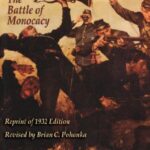Young Glenn Worthington was curious about the sounds and sights outside his home and peeked through the oak boards his father had nailed over the cellar windows to protect the family. Glenn could see the blue-clad legs of Union troops as they raced passed his house and then the Confederate soldiers as they rolled artillery into place. As an older man, Worthington recounted his experience in his book Fighting for Time which was first published in in 1932, sixty-eight years following the Battle of Monocacy.
The book is a skilled blend of personal reminisces and a well-researched narrative of the time leading up to the battle, the fighting, and the aftermath of that day in early July. Worthington remembers seeing: “men fleeing from deadly peril, panting aloud mingled with exclamations of pain and terror.” He recalls the sounds of artillery shells that “seemed to be in flight from every direction, and the horrible hissing and screeching they made … perhaps more dreadful to the imagination than they were in effect.”
One of the earliest histories of the “battle that saved Washington,” Worthington’s book draws on a wide variety of reliable and authentic sources to tell his story, including the Library of Congress, Peabody Institute Library in Baltimore, Battles and Leaders of the Civil War, The Official Records of the Union and Confederate Armies, and a host of personal recollections from both military and civilian sources. In addition to messages sent back and forth between military leaders in Washington and the field leading up to the battle, the author includes messages sent by J. W. Garrett, President of the Baltimore and Ohio Railroad, to Union military and civilian leadership. Garrett played a key role in providing intelligence on Confederate troop movements as well as directing the transportation of Union troops to the Monocacy battlefield.
Worthington builds the case for the importance of the Battle of Monocacy in averting a disaster two days later when Confederate forces reached Washington. Among the references he cites to underscore the importance of Monocacy is that from Benson J. Lossing’s History of the Civil War: “But for that check of thirty hours [at Monocacy], the Capital would have been Early’s prize and a heap of blackened ruins its possible fate …The Battle of Monocacy appears as one of the most important and brilliant of the war.”
Despite the fact that his family leaned toward the Confederate cause, Worthington’s account is balanced and takes care to report both Union and Confederate leadership fairly for their military decisions and actions. In his conclusion, Worthington makes clear his commitment to the Union cause. At a protected Monocacy battlefield “patriotic Americans would come, from the North, from the South, from the East and from the West, and there on the ground where brave men, North and South, fought and fell, rekindle the flame of patriotic devotion to flag and country; renew their allegiance to the Constitution and Union …”
There are a number of personal experiences covered in the book which provide an important human dimension to the battle and its impact. Among the stories is one about the author at the time just following the battle. The six-year-old Worthington explores the area outside his home and finds a stack of abandoned Federal arms – guns and bayonets – that are being burned by the Confederates. Eager to retrieve a Union bayonet as a souvenir, Worthington attempts to draw one out of the embers using a stick and barrel stave. In disturbing the coals, a paper rifle cartridge is set off, exploding in the boy’s face. Initially it was thought that he was blinded by the explosion, but Worthington escaped with seared skin, eyebrows burned away, and eyelashes “crisped.” His eyesight was spared.
Glenn Worthington went on to become an attorney and later a judge in Maryland. He also became a leading force in the Monocacy Battlefield Association. In 1934, shortly before his death, Congress established a park to commemorate the Battle of Monocacy. Later in the 1970’s, the National Park Service secured the battlefield boundary, expanding the size to 1,670 acres.
Worthington’s book, Fighting for Time, published in 1932, was revised in 1985 and reprinted in 1988 by White Mane Publishing Company. It was reprinted by Burd Street Press in 2007. Other accounts of the Battle of Monocacy have been published since Worthington’s book, but Fighting for Time remains the only comprehensive account written by an eye-witness who also played a leading role in preserving the battlefield for those of us in the twenty-first-century. The book is well worth reading for its unique perspective on Civil War America and the background of its author.
Photo of Fighting for Time, Burd Street Press, Reprint edition, 2007.


Recent Comments